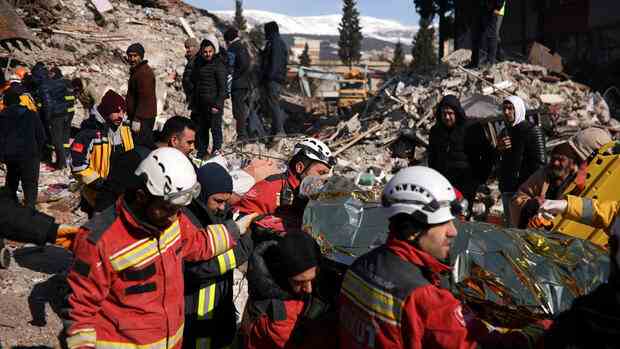Rome Tents, camp beds, sleeping bags and winter clothing are taken out of the hangar on pallets. The Air Force loaded 50 tons of relief supplies here during the night, as can be seen on Bundeswehr videos. The first three Airbus A400Ms took off for Turkey on Thursday morning.
Until next week, three of the heavy military transporters are to fly daily from the Wunstorf air base in Lower Saxony to the earthquake area. The Ministry of the Interior spoke of material with a total value of one million euros. In Berlin, Turkish Airlines passenger planes were also loaded with tons of relief supplies.
The international aid from the West after the devastating earthquakes in Turkey and northern Syria is enormous – especially for Turkey: not only Germany is involved. Rescue teams come from the USA, from Italy, from France. Even Cyprus, which has been at odds with Turkey for years because of the occupation of the northern part of the island, has sent 21 rescuers to the earthquake area. In total, more than 100,000 helpers from Germany and abroad are said to be in action.
The situation is different when it comes to aid for Syria. Although funds have been promised for both countries, Berlin is increasing humanitarian aid, as is the European Union. So far, however, the West has had difficulties with aid deliveries to the civil war country – also for fear of strengthening the dictator Bashar al-Assad.
Only one border crossing to Syria is open
The world is divided. There is Turkey: Already on Monday evening, a few hours after the earthquake with a magnitude of up to 7.7 on the Richter scale, the first volunteers from Germany set off for Turkey with sniffer dogs. On Wednesday, the non-profit organization @fire from near Osnabrück sent a second team to look for people who had been buried.
The hope of finding survivors under the rubble is fading with every passing minute: “It’s always a race against time,” says Sebastian Baum, spokesman for @fire. “With 72 hours, the chance of survival is almost zero.” Added to this is the cold: the temperatures in the crisis area are around freezing. The death toll rose to more than 20,000 on Thursday, and around 70,000 people are said to have been injured.
And then there is Syria, where the aid is arriving in rather dabs. “The international community must not forget the people in northern Syria,” says Christian Katzener, Managing Director of Doctors Without Borders in Germany. A large-scale international relief effort for the region and “clear support from humanitarian organizations already working in the region” are needed.
>> Read here: How the earthquake could lift Syria out of isolation
War has been raging in Syria since 2011, more than half a million people have died according to international estimates, and around 5.6 million Syrians have fled to other countries, according to the UN.
Cold and hunger in the disaster area: The situation in Syria is becoming increasingly desperate
Assad’s regime currently controls a good two-thirds of the country. Aid supplies that come into the country via the capital Damascus are distributed by Assad’s men. There have been several reports that the government is enriching itself and selling goods to its own people. The distribution of relief supplies is also said to have bypassed areas that Assad regards as hostile.
The region hit by the earthquake covers areas controlled by Assad, but also the rebel province of Idlib. Currently there is only one open border crossing between Turkey and the Syrian rebel areas, Bab al-Hawa. The UN Syria mediator Geir Pedersen appealed to the Syrian government not to block aid supplies to regions outside of government control. “We have to make sure that there are no political obstacles to getting the aid to where people are affected,” said Pedersen in Geneva.
The Turkish government is now trying to open the border posts controlled by the Syrian government. The crossings have been closed for years due to tensions between the two countries. “We are always dependent on cooperation with the authorities during an operation,” says @fire spokesman Baum. It worked well in Turkey, but things are different in Syria. “Unfortunately, helping with an earthquake is always very political.”
Detergent is used instead of rescue equipment
However, Syria is not completely cut off from international aid either: Oman launched an airlift with relief supplies on Wednesday, but does not want to send rescue teams into the country. The United Arab Emirates pledged $50 million in aid and want to set up a field hospital. India has also sent relief supplies by plane. The Syrian leadership has also been assured support from Iran, Russia and China – direct or indirect supporters of the ruler Assad for a long time.
>> Read here: Insurers under pressure – Natural catastrophes are becoming more frequent and more frequent
The Syrian government took the earthquake as an opportunity to once again criticize the Western sanctions imposed by the USA and the EU because of the regime’s brutal actions in the civil war. They would make it more difficult to help the population.
However, experts doubt that lifting the sanctions would have a direct impact on the urgently needed emergency aid. Around 4.5 million people live in the north-west of the country that is not controlled by Assad. According to the UN, 90 percent of the population there were already dependent on humanitarian aid before the earthquake disaster.
In the course of Thursday, the first six trucks then passed the border to Syria, as the UN announced. However, local activists reported that these were aid deliveries that had been planned before the earthquake. Instead of vital equipment for the rescue teams, detergents, among other things, had arrived.
More: Millennium catastrophe in Turkey: Criticism of Erdogan’s crisis management is growing
